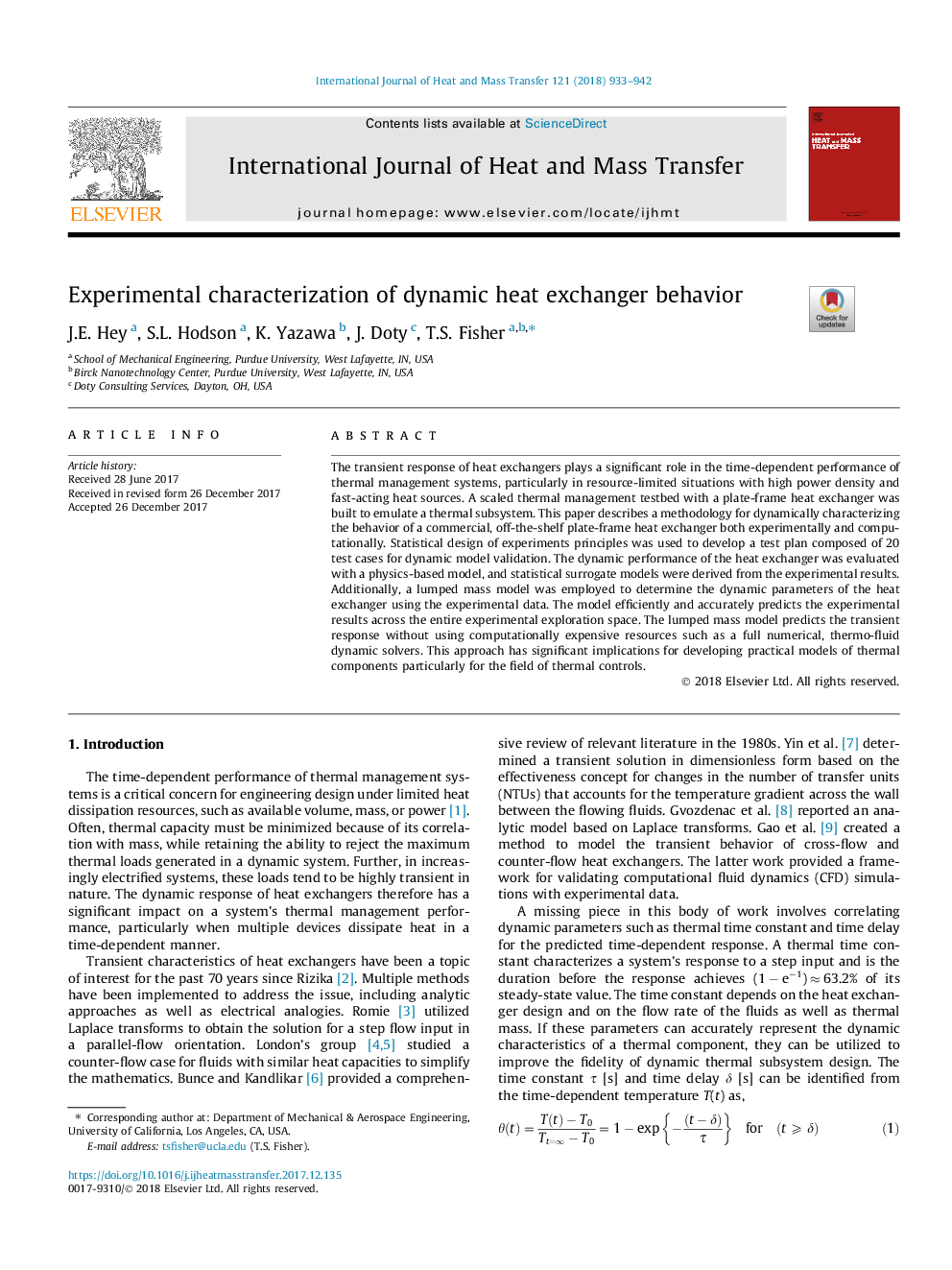| کد مقاله | کد نشریه | سال انتشار | مقاله انگلیسی | نسخه تمام متن |
|---|---|---|---|---|
| 7054542 | 1458019 | 2018 | 10 صفحه PDF | دانلود رایگان |
عنوان انگلیسی مقاله ISI
Experimental characterization of dynamic heat exchanger behavior
ترجمه فارسی عنوان
خصوصیات تجربی رفتار مبدل حرارتی پویا
دانلود مقاله + سفارش ترجمه
دانلود مقاله ISI انگلیسی
رایگان برای ایرانیان
ترجمه چکیده
واکنش گذرا مبدلهای حرارتی نقش مهمی در عملکرد وابسته به زمان سیستم های مدیریت حرارتی دارد، به ویژه در شرایط محدود منابع با تراکم توان بالا و منابع گرمای سریع عمل می کند. سیستم حرارتی مقیاس سنجی با یک مبدل حرارتی با صفحه ای آزمایش شده است تا زیر سیستم حرارتی را تقلید کند. این مقاله روش شناسی برای توصیف پویایی رفتار یک مبدل حرارتی بر روی صفحه نمایش تجاری را به صورت تجربی و محاسباتی توصیف می کند. برای طراحی یک طرح آزمایشی از 20 نمونه آزمون برای اعتبارسنجی مدل پویا، از طرحهای آماری اصول آزمایش استفاده شده است. عملکرد پویای مبدل حرارتی با یک مدل مبتنی بر فیزیک مورد ارزیابی قرار گرفت و مدل های جایگزین آماری از نتایج تجربی حاصل شد. علاوه بر این، برای تعیین پارامترهای دینامیکی مبدل حرارتی با استفاده از داده های تجربی، از یک مدل توده توده ای استفاده شد. این مدل به طور موثر و دقیق نتایج تجربی را در کل فضای اکتشافی تجربی پیش بینی می کند. مدل توده توده ای پیش بینی پاسخ گذرا بدون استفاده از منابع گرانقیمت محاسباتی مانند حل کننده پویای عددی کامل، حرارتی مایع است. این رویکرد برای توسعه مدل های عملیاتی اجزای حرارتی به خصوص در زمینه کنترل های حرارتی معنی دار است.
موضوعات مرتبط
مهندسی و علوم پایه
مهندسی شیمی
جریان سیال و فرایندهای انتقال
چکیده انگلیسی
The transient response of heat exchangers plays a significant role in the time-dependent performance of thermal management systems, particularly in resource-limited situations with high power density and fast-acting heat sources. A scaled thermal management testbed with a plate-frame heat exchanger was built to emulate a thermal subsystem. This paper describes a methodology for dynamically characterizing the behavior of a commercial, off-the-shelf plate-frame heat exchanger both experimentally and computationally. Statistical design of experiments principles was used to develop a test plan composed of 20 test cases for dynamic model validation. The dynamic performance of the heat exchanger was evaluated with a physics-based model, and statistical surrogate models were derived from the experimental results. Additionally, a lumped mass model was employed to determine the dynamic parameters of the heat exchanger using the experimental data. The model efficiently and accurately predicts the experimental results across the entire experimental exploration space. The lumped mass model predicts the transient response without using computationally expensive resources such as a full numerical, thermo-fluid dynamic solvers. This approach has significant implications for developing practical models of thermal components particularly for the field of thermal controls.
ناشر
Database: Elsevier - ScienceDirect (ساینس دایرکت)
Journal: International Journal of Heat and Mass Transfer - Volume 121, June 2018, Pages 933-942
Journal: International Journal of Heat and Mass Transfer - Volume 121, June 2018, Pages 933-942
نویسندگان
J.E. Hey, S.L. Hodson, K. Yazawa, J. Doty, T.S. Fisher,
